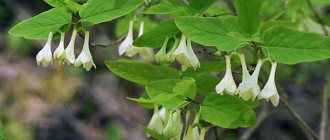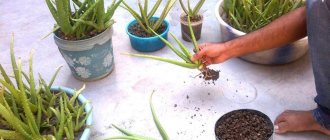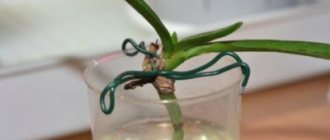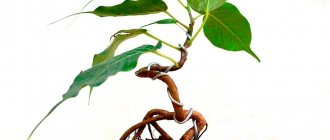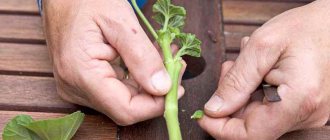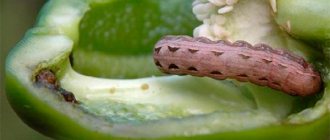Plant varieties
Increased interest in fuchsia is an incentive for breeders, so now you can find different colors of this crop.
There are also species that bloom at different times of the year. The three-leaf plant has the appearance of a long bell of bright red color. This is a low shrub that grows faster in width. Blooms from May to mid-autumn. In summer it can withstand direct sunlight.
Magellan is a two-color species - a combination of purple and red shades in peduncles. The shrub can reach 3 meters in height, so it is preferable to grow it in greenhouses.
Sparkling fuchsia is a tall two-meter bush. Unopened red buds. When the sepals open, deep purple terry petals appear. Capable of blooming all summer. Looks good in ensembles and flower arrangements.
Alisson Bell is a combination of soft pink sepals and bright pink semi-double petals.
Anabel is a white terry fuchsia. The flowers are large with splashes of pink.
Ballerina - sepals of rich pink, almost cherry color, the skirt is white with a pinkish tint, densely doubled. The flowers are small in size, but the entire bush is dotted with them.
Blue Angel - a combination of white sepals and blue petals of the skirt. Double flowers.
Hollies Beauty has elongated buds that combine white sepals and a skirt with a soft lilac hue.
Archie Owen is a fuchsia with large, densely-double pink flowers. Sepals are wavy.
Bella Rosella is a species that has some of the largest flowers. The color is rich pink. Always blooms profusely and for a long time.
Blue Vale - can be bush or canopy. The skirt is soft lilac, the sepals are white. Sets many buds and blooms from spring to late autumn.
Cecil is a densely double form with pink sepals and lilac, lavender-like wavy petals.
Varieties and types
Ampelnaya
Ampel fuchsia is not a separate variety, it is rather a variety of plant, the structure of which includes various subspecies and varieties. A special feature is the ability of flexible stems to droop, forming a beautiful lush cap, literally dotted with flowers.
Holly's Beauty
One of the famous varieties of ampelous fuchsias is Holly's Beauty, bred in England in 1989. Holly's Beauty is an amazing variety. Quite long graceful buds open into bluish-white double flowers, decorated with thin white threads-stamens. The plant takes root very well.
Blue satin
Blue satin
Also an ampelous form. Very flexible drooping branches, entirely covered with greenish leaves with a red tint. An unusually large flower with a soft purple skirt is complemented by pink sepals with white-greenish tips. To be decorative, the bush must be shaped; in the spring, the plant requires good pruning. With proper feeding, it responds with powerful flowering.
Blue angel
Blue angel
Low, up to 30-45 cm, semi-ampelic fuchsia with very large double flowers. In addition to flowers, the variety is decorated with dark green, slightly jagged leaves and elongated beautiful buds.
The color of the sepals is white, the tips are greenish. The pink coating of the skirt emphasizes the subtle blue of the petals. The scalloped edges give the flower an airy feel.
Cuttings are very easy to root; in suitable conditions the plant overwinters well.
Annabel
Annabel
One of the white princesses in the kingdom of fuchsias. It amazes, especially beginners, with its “porcelain”, fragile-looking flowers. The snow-white skirt bashfully exposes the pinkish stamens, the wreath of slightly pinkish sepals is almost a crown. The leaves are a delicate light green color at first; as they mature, the leaf blade darkens.
An important condition for preserving the decorative effect of flowers is to avoid direct sunlight.
The plant is obedient to formation - right up to the standard. The advantage of this variety is its active growth and early flowering.
Bella Rosella
Bella Rosella
The variety is unique in its versatility. Very fast growth with a powerful growth of non-fragile shoots allows you to form a plant, both in the form of a standard and in an ampelous form.
Very large flowers, with an intense pink, even purple, skirt and a delicate white-pink “crown” of sepals turn a “tree” or a lush bush into lacy foam. The flower is worthy of becoming an adornment of the most exquisite collection.
Royal mosaic
Royal mosaic
One of the most common and favorite varieties of fuchsias. Very large, “fluffy” (double) flowers are original in color and shape. The blue-violet skirt, rich in tone, is set off by pink “strokes-splashes”. The sepals are white on top and, when fully opened, show a pink underside, which looks very decorative, especially in combination with rounded large white buds. The background is also beautiful - slightly jagged, bright shades of green leaves.
It blooms luxuriantly and grows intensively - a wonderful variety in all respects, both for amateurs and professionals.
New Millennium
New Millennium
This is an amazing, very original and unusual variety. Bushy, beautifully and quickly branching, fuchsia lends itself well to shaping. But the view of a flowering plant is especially good. On a light green background of thin leaves, surrounded by large lilac buds, double flowers of unusual colors bloom.
The dark red (to black) skirt becomes cherry at the end of flowering, but seems to glow from the inside.
The red sepals add a glow and wonderfully frame the center of the flower with its long, graceful stamens.
Voodoo (voodoo)
Voodoo (voodoo)
It is distinguished by its unusually beautiful colors, contrasting and very bright. The dark purple skirt surrounded by intense red sepals and heart-shaped buds immediately attracts attention. The remaining qualities are also good - power and speed of growth, abundant flowering, easy formation. The variety is suitable for beginner gardeners.
La campanella
La campanella
A small-flowered but profusely flowering variety, usually grown in a hanging form. White sepals above a lilac skirt look like lavender mist enveloping a lush bush.
How to plant seedlings in flower pots
It is recommended to plant seedlings in a hanging pot once the root system becomes strong and resistant to external influences. Before planting, it is recommended to moisten the soil generously and replant the flower using the transshipment method. This will protect sensitive roots from injury.
When planting a young sprout of an ampelous variety in a pot, tilt it slightly, placing it closer to the edge of the pot. In the near future, this will make it possible to form a cascading waterfall with bright inflorescences from a lush bush. It is better to choose a clay pot. It will protect the root system of the flower from summer heat and burnout.
By following the rules for growing and caring for young shoots, the owner will receive an amazingly beautiful bush. It will delight you for a long time with its bright buds and lush greenery.
vote
Article Rating
How to form a standard fuchsia?
A real tall tree (up to 1 meter in height) can only be obtained in natural conditions or in special greenhouses, since the trunk needs good and, most importantly, uniform lighting. In an apartment, this interesting activity will also lead to results, but the tree will be small.
To form a trunk you need:
- choose a suitable cutting. It should be strong, rooted, and, preferably, upright;
- tie the cutting to a high peg;
- feed with fertilizers containing mainly nitrogen. Further, during formation, it is necessary to use only such fertilizers;
- place the cutting in the light;
- as they grow, remove all buds and shoots (lateral);
- after waiting for the required height (about 1 year), pinch the top;
- Then pinch the resulting crown according to the usual rules.
When forming a trunk in a city apartment, fuchsia must be turned towards the light so that the crown is uniform.
Transfer
Fuchsia is replanted in early spring before the growing season begins. Young plants, the root system of which develops quickly, are replanted annually. Adult flowers need to be replanted every 2-3 years or even less often. Fuchsia does not tolerate transplantation well, therefore, until its roots have outgrown the pot, this procedure is not carried out.
To transplant fuchsia at home, you need a small and low pot. It should be 1-1.5 cm wider than the previous one.
You should not replant the flower into a spacious pot - problems with flowering may occur. Until the roots of fuchsia have mastered the entire earthen ball, it will increase leaf mass, but not bloom. Therefore, it blooms best in cramped pots.
It is necessary to place drainage at the bottom of the flower pot to drain excess water. In addition to pebbles and expanded clay, you can put pieces of charcoal there to protect the root system from rot.
Replant the plant by transshipment in order to damage the roots as little as possible.
It is carefully removed from the pot along with the soil and placed in a new pot. To fill the volume, use fresh earthen mixture for fuchsias
The plant should not be deeply buried. It should be no lower after the transplant than before it. After the procedure is completed, the flower is watered and placed in partial shade for 1-2 weeks.
To fill the volume, use fresh earthen mixture for fuchsias. The plant should not be deeply buried. It should be no lower after the transplant than before it. After the procedure is completed, the flower is watered and placed in partial shade for 1-2 weeks.
How to make fuchsia bloom?
The reasons that fuchsia does not bloom are almost the same as described above. You can only add incorrect fertilizing (abuse of nitrogen, for example, leads to an increase in excess green mass), as well as pinching (formation must be stopped one or two months before flowering).
Only all measures in combination will help to make your pet bloom:
- Transplant the fuchsia into a tighter pot;
- Water as the soil dries out;
- Organize proper lighting - a calm, bright place with diffused rays;
- Feed with phosphorus and potassium, removing nitrogen fertilizers from the “diet”.
Common problems
The plant is susceptible to pests such as mites or whiteflies. Their waste products are found on the back of the leaves. They fight by spraying with special solutions that are sold in flower shops.
The leaves begin to wither and grow poorly in stagnant air; the flower needs freshness, but drafts should not be allowed.
The reason for a too short flowering period is high temperature and abundant watering in winter or lack of moisture and light in spring.
Falling buds in summer means lack of moisture or too high a temperature.
The spotted color of the leaves indicates too much watering.
How to properly form a plant?
The formation of a flower bush is done by pinching the top growth point . And the more fuchsia shoots formed at the very beginning of growth, the more magnificent the plant will bloom.
This must be done if you want to have fluffy fuchsia on your windowsill, since some varieties do not branch, and they need help with this by pinching. It is worth remembering that during this process the plant will not bloom, but in the end you will get a lush, flowering bush on the windowsill.
In order for the plant to be properly formed, the removal of growth points from the shoots is carried out in three stages, while complete formation takes approximately 2-3 months. The plant will bloom in the second month after the last pinching , but only if the daylight hours at this time are long enough. If fuchsia was bred in the autumn, then you can install artificial lighting and admire the flowering plant in winter.
We recommend watching a video about pinching fuchsia:
2.Fuchsia care at home
2.1.Reproduction, growing from seeds
Fuchsia propagates vegetatively - by stem cuttings 8 - 10 cm long or by sowing seeds in the spring.
The lower leaves are removed from the cuttings and the bases are dipped in rooting powder.
For planting, prepare small plastic cups or pots with drainage holes.
The bottom of the containers is lined with a layer of small pebbles, expanded clay or foam balls - such a layer will help quickly remove moisture from the roots.
Fill the cups with nutritious and loose soil, the surface of which is thoroughly moistened using a sprayer with water at room temperature.
The bases of the cuttings are immersed 1–2 cm into the soil surface.
Cover young plants with clear plastic or glass to maintain even humidity.
New growth usually appears within a month. Cuttings can even be rooted in water.
2.2.House maintenance, pruning
If it is possible to keep the plants cool during the dormant period, caring for fuchsia will not take much time and effort. Some varieties require regular pinching of the apical buds to form a dense crown - others can be formed as a standard tree. It will also be very interesting to grow fuchsia as a flowering tree - bonsai. Tall plants may need support to grow. Remove fading flowers promptly to extend flowering time. Tall fuchsias will need formative pruning, which is carried out in early spring.
Take fuchsias into the garden in the warm season, taking care to gradually acclimatize the plants to new conditions. In autumn, plants may lose leaves - this is normal for some species. The faded shoots of the plant are cut off, and after a month they begin to grow again and often repeat flowering. Weak, diseased shoots of the plant should be removed using a sharp, sterile pruning instrument.
2.3.Transplanting fuchsia
Fuchsia prefers cramped conditions at home - this way its flowering will be more abundant. Repot plants in early spring, before new growth occurs. The pot for planting plants should have large drainage holes.
From spring to autumn, fuchsias can bloom very profusely and continuously.
2.5.Diseases and pests
Leaves shrink when not watered enough. Direct rays of the sun on hot days can cause burns on the leaves. Overdrying of the soil during the flowering period causes the plants to shed their buds. Leaf tips become brown and dry when kept in too dry an atmosphere. One of the most common problems is that fuchsias can drop their leaves, sometimes this happens in the fall before the plants go into dormancy and then this is normal. When grown in conditions of high humidity, fuchsia leaves may also turn yellow and fall off - magnesium deficiency can cause similar symptoms.
Among the harmful insects on plants, whiteflies, aphids, and spider mites sometimes appear.
Diseases and pests
Fuchsia rarely gets sick, but problems can arise with it. For example, a plant will not feel well if there is stagnant air in the room. Fuchsia loves freshness very much, but is also sensitive to drafts.
If the flowering of your fuchsia quickly ends, pay attention to watering and the temperature at which the plant overwintered, because this can be caused by too much watering or warm wintering temperatures. This also happens due to a lack of light and liquid in the spring and summer. If this plant is exposed to bright light in winter, it will most likely shed its leaves.
During this period, it can be moved to a slightly more shaded place. If buds appear in winter, they need to be plucked off. At other times, leaf fall is associated with low humidity and a general lack of moisture, as well as hot temperatures.
The fall of buds occurs from a small amount of light and extreme heat, as well as from inconsistent watering. Another reason for the buds to fall off will be the movement of the fuchsia during flowering or drafts. With excessive watering, especially in winter, fuchsia begins to suffer from spots that affect its leaves. This plant can also be affected by pests. The most common of these are whiteflies and spider mites.
Description of fuchsia
Fuchsia is a shrub or tree. Its leaves can be arranged oppositely or collected in whorls. Some species begin to shed their leaves during the dormant period. The shape of the leaf plates can be different, most often they are slightly elongated. The edges of the sheet may be jagged or smooth. The plant's recognizable flowers can be colored in shades of white, pink, purple or red. They have a prominent tube-shaped calyx decorated with protruding stamens. The petals and calyx can be plain or painted in different colors and shades.
There are varieties with double flowers. The wide palette of fuchsia colors, including quite rare tones, gave the name to one of the shades of purple, as well as to a chemical compound with a solution of a similar color - fuchsin.
It is known that growing in its homeland, fuchsia produces completely edible berries, which are quite difficult to obtain indoors. Often dishes are decorated with flowers of this plant, which, by the way, are edible.
Growing FUCHSIA from A to Z!
Watch this video on YouTube
Plant characteristics
Fuchsia is native to the Caribbean islands, where it was first discovered by a French scientist in 1696. The flower got its name in honor of a German botanist named Fuchs.
The perennial plant belongs to the fireweed family, which includes about a hundred species. Representatives of this group are found in the wild in New Zealand, Peru, Chile, Mexico, Argentina, and also on the Falkland Islands. As for natural conditions, fuchsia does not prefer partial shade and therefore most often grows under dense tree crowns.
Appearance of fuchsia
The advantage of fuchsia is its rapid growth and long, abundant flowering.
That is why the plant is very popular among lovers of home flowers. The appearance of the flower suggests the following features:
- The color of the leaves varies from green to reddish.
- The stems are flexible. The plant can be bushy or creeping.
- The shade of the flowers, sitting on thin stalks, depends on the variety.
- The surface of the petals can be smooth or terry.
- The arrangement of the leaves is opposite.
- The shape of the leaves is different and depending on the variety it can be:
- ovoid;
- lanceolate;
- serrated;
- entire;
- crenate.
- The fruits are similar to berries.
- The long, richly colored stamens that look outside the flower give the plant a special grace. The picture is complemented by a dense, brightly colored pistil, which rises above the surrounding stamens.
The lifespan of one specimen with proper care can reach 50 years.
Watering
In spring and summer, during active growth and flowering, fuchsia requires abundant watering. However, you cannot overdo it - the roots may begin to rot and the plant will die. Watering should be done when the top layer of soil in the pot has dried out a little. The water should be settled, soft, and at room temperature.
As flowering comes to an end, watering is reduced. In winter, if the room is cool (up to 12 degrees), you need to water the plant 1-2 times a month.
Fuchsia is very demanding when it comes to watering and does not tolerate drying out of the soil. Complete drying of the earthen coma leads to the death of the plant. It is necessary to monitor the condition of the soil in the flower pot. With a lack of moisture, the leaves droop and look lethargic, and the plant itself may drop flowers and buds.
During cool wintering, the soil in the fuchsia pot should remain moist. Reducing watering is due to the fact that at low temperatures and excess moisture, pathogenic fungi quickly multiply, leading to root rot. But excessive dryness of the soil in winter is just as harmful for the plant as in summer.
Trimming
To grow the healthiest plant possible, by winter gardeners usually trim off the withered leaves themselves in anticipation of new shoots in the spring. You should also regularly trim diseased and broken branches.
In the spring, young shoots are cut off by a couple of centimeters if a lush crown of the bush is expected to form. This procedure is carried out twice, with an interval of two weeks.
Plant pruning
Attention! If the flower is grown indoors, then fuchsia needs to be trimmed less often than in open ground. Some lovers try to form a standard fuchsia by regularly cutting off its side shoots
It is difficult to say how productive this activity is. There are only verbal descriptions of how a small tree was allegedly obtained from a bush. It’s impossible to even find photographs of such plants.
Some lovers try to form a standard fuchsia by regularly cutting off its side shoots. It is difficult to say how productive this activity is. There are only verbal descriptions of how a small tree was allegedly obtained from a bush. It is impossible to even find photographs of such plants.
Diseases
Problems with fuchsia can arise due to non-compliance with home care rules, or due to pest infestation. Let's look at the most common diseases.
Root rot. Appears due to a large amount of moisture. To get rid of the problem, you need to remove the plant from the pot, wash the roots with warm water, cut off the rotten roots, and place the plant in a container with clean water. When new, young roots appear, it is allowed to plant the flower again in new soil.
Gray rot. It affects leaves due to high indoor humidity. In this case, the damaged leaves need to be cut off and the room regularly ventilated.
Slow growth. Most often it happens due to lack of space in the pot, so the fuchsia should be replanted.
Lack of microelements. If the leaves wither and lighten, there is not enough nitrogen; when they turn yellow, there is not enough manganese; when they dry out, acquiring a brown tint, there is not enough molybdenum.
Whitefly infestation. This insect lays eggs on the back of leaves
As a result, white droplets can be seen on the leaves, after which the leaves turn yellow and fall off. To combat it, it is necessary to wash the flower with soapy water, paying special attention to the inside of the leaf and the stem, but protecting the roots from water.
Red spider mite infestation. The main signs are gray plaque and black dots on the sheets
To combat, use special insect repellents.
Compliance with basic rules of care and timely detection of diseases will allow you to grow a large flower, which will delight all residents with its blooming, and will become a real decoration of both the room and the garden. Considering all the features, we can call fuchsia a picky plant, but this does not mean that it does not need proper care.
Caring for indoor fuchsia
There are many varieties of fuchsia, but the most common indoor fuchsia is hybrid fuchsia (Fuchsia hybrida). This is what you can most often find in our apartments.
Lighting
Indoor fuchsia is a rather unpretentious plant; it loves full lighting, but on hot summer days it is advisable to shade it. It is better to keep it on windows facing east or west. With insufficient lighting, fuchsia shoots become elongated, which does not look very attractive.
Temperature
For abundant flowering of the plant, the optimal temperature in the room should be no lower than 20 degrees; after flowering during the dormant period, it is better to keep fuchsia in a cool room at a temperature of 10-14 degrees.
Watering fuchsia and humidity
On summer days, the plant should be watered twice with settled, soft water. In the spring-autumn period, watering is reduced to once. During the winter months, the soil should dry out completely between waterings; during this period, it is better to water fuchsia once every two weeks. When watering the plant, do not forget about air humidity. This has a beneficial effect on the duration of flowering. If the weather is hot, dry, you can spray indoor fuchsia twice a day; in cooler times, twice a week is enough. In winter, the plant does not need spraying.
Substrate for fuchsia
Don't forget about the condition of the soil. The easiest way is to buy ready-made soil in a specialized store. But if you decide to prepare the soil for your favorite plant yourself, know that homemade fuchsia loves soil containing equal parts peat, rotted manure, leaf soil, sand and alumina.
Replanting and pruning fuchsia
In early spring, start replanting indoor fuchsia, but first trim its branches to the woody part of the stem. This will give the flower a more compact and beautiful shape in the future. Choose a pot one size larger than the previous one and be sure to have drainage holes. Don't forget to put a layer of expanded clay on the bottom.
Fuchsia propagation
After pruning the plant, do not throw away the cuttings. You can get new plants from them, since indoor fuchsia propagates by cuttings and seeds. Remove the lower leaves from the cuttings, leaving no more than 3-4 upper leaves, and place them in water or wet sand. For good rooting, maintain the temperature at least 20 degrees. Periodically spray the cuttings and change the water. Usually after two weeks the plant takes root. After this, the cuttings are planted in pots with ready-made soil mixture.
Feeding fuchsia
As soon as buds appear on the indoor fuchsia, you should start applying fertilizer. It is enough to water once a week with liquid fertilizer for flowering plants, diluted in accordance with the instructions. At the beginning of autumn, feeding is stopped. Don’t forget, fertilizers should only be applied to moist soil!
Fuchsia diseases
Indoor fuchsia is very rarely susceptible to disease. If the humidity is very high, powdery mildew may appear or the roots may begin to rot. When the soil becomes too dry, leaves and buds fall off. Also, the falling of buds can be caused by moving the plant from place to place and drafts.
Indoor gerberaIndoor trees: care, choice, features
After this article they usually read
Add a comment
How does fuchsia reproduce?
In fact, even a schoolchild can propagate a plant: just buy a ready-made plant in a store and divide it into cuttings. Soon you will have a whole mini garden of fuchsias. However, you can grow a flower from seeds, but this method is longer and more labor-intensive, which is why it is used mainly by breeders. It’s no joke, the seeds will need to be nurtured for six months to get young seedlings, but they will begin to bloom only after two years.
Cuttings allow you to obtain new seedlings with a ready-made root system within a month. In addition, vegetative propagation allows you to preserve all the characteristics of the mother plant. It is worth noting that it is better to do cuttings in the fall, after the fuchsia has faded.
How to propagate fuchsia at home
Fuchsia is a beautiful indoor plant with bright wedge-shaped leaves and unusually shaped flowers, which is not particularly difficult to grow at home.
She has long earned the love of flower growers. But, if the flower is not too demanding in terms of care, then reproduction may be difficult. The photo below shows how to properly cut a flower.
How to get fuchsia seeds
To get seeds, you need to select several newly blooming flowers. Remove the anthers from the rest. Then apply pollen from another adult plant to the pistils of the remaining flowers using a cotton swab or brush.
After about a month, the plant will ripen the fruits, which need to be cut and the seeds carefully removed. To prevent rotting, the seed material is left to dry. They are then placed in paper bags for storage or planted immediately.
Interesting! With this method of propagation, the flowers on the new plant may differ in color from the mother plant.
How to sow seeds correctly
First you need to prepare the soil:
- For three parts of a universal store bought one, take two parts of peat and one part of
sand. Before planting, treat the soil with a solution of potassium permanganate to remove possible pests. Place expanded clay at the bottom of the container to prevent the water from stagnating. - Fuchsia seeds are large, so you can plant them either in a common container or in separate ones (yogurt containers are suitable).
- The soil needs to be compacted, otherwise you will have to wait a long time for seedlings. Place the seeds in small depressions, do not sprinkle them.
- Place the glasses on a tray or other suitable container, cover with a cut plastic bag and cling film. Remove the cover every day for ventilation.
- Monitor the condition of the soil, water periodically, avoiding waterlogging.
- After emergence of seedlings, remove the cover.
Further care at home comes down to regular watering. As soon as the fuchsia bushes grow a little and get stronger (after about 2 months), they can be transplanted into pots.
Reproduction of a flower by cuttings and its further cultivation are not difficult, the main thing is to do everything according to technology.
Cuttings
The optimal time for cutting is spring or autumn:
- Only young green shoots are suitable, which are cut with a sharp knife or pruning shears;
- leaves are removed, leaving 2 -
3 pairs of top ones; - the resulting seedling is placed in water with the addition of a growth stimulant or a container with moistened soil for rooting.
When planting in the ground, you need to make sure that the lower leaves do not touch the ground. For successful rooting, cover the container with the plant with plastic wrap or a plastic bottle cut in half. The mini-greenhouse needs to be opened periodically to prevent mold from appearing.
When cuttings are taken in the spring, the roots will appear in a couple of weeks; in the fall, the process may take a month. Afterwards the plants are planted in pots. To begin with, the smallest ones, with a diameter of 9, are suitable –
10 cm.
For good plant growth and development, it is better to choose a soil mixture that is weakly acidic. Since purchased soil often consists of only humus and contains debris or weed seeds, you can prepare a nutrient mixture yourself. Take one piece of humus and turf for two parts of sand. And most importantly, do not forget about drainage.
How to root fuchsia leaves
The easiest way to propagate is using leaves:
- cut healthy leaves are placed in a shallow container with soil, compacted and covered with film;
- further care consists of daily ventilation and moisturizing as needed;
- after new shoots appear (after 15–30 days), the plants are transplanted into separate pots.
Features of plant breeding
Novice amateur flower growers are not afraid to breed this beauty on their own. In stores they buy a ready-made flower that has at least one long shoot, and as a result they will get several plants. Indeed, there is nothing complicated about plant propagation. Fuchsias are bred in two ways: vegetative or seed .
The seed method is used mainly by breeders. But vegetative propagation is quite often applicable at home. Moreover, it will take about 6 months to grow a young plant from seeds, but it will bloom only in the second year of life. And you can root the shoot after a month. Also, the cutting method retains all the characteristic properties of the mother plant.
Any part of the plant, except flowers, can easily be used as a starting material. This may be a large leaf or woody cuttings, but they take longer to germinate and are more difficult. For propagation, it is best to take a young mature shoot .
ATTENTION : The appropriate time for the growing season is considered to be spring or autumn; in summer it is quite hot, and it is more difficult for shoots to take root. In principle, rooting can be done at any time of the year, only with more effort.
For more details on whether it is better to grow fuchsia yourself or buy an adult flower in a store, as well as how best to plant a flower - with seeds or cuttings, read this article.
Fuchsia: growing and care at home
Growing and caring for this plant at home is suitable even for novice gardeners. Although there are many varieties, their care is generally the same.
Temperature
The best temperature for proper growth and development in summer is 18-20 degrees. The plant does not tolerate high temperatures. If possible, in summer it is useful to take fuchsia outside, but under no circumstances under the scorching sun.
Important! In winter, the acceptable temperature is 8-10 degrees. The soil should not be overcooled, this can harm the plant
Lighting
Like many other indoor plants, the fuchsia flower does well in a bright room with diffused sunlight. If there is little natural light, you can use artificial lighting. Fluorescent lamps are perfect for this. If there is not enough lighting, fuchsia will not bloom. You cannot place the flower in direct sunlight, as burns may appear on the leaves.
Watering
In summer, watering should be abundant and frequent, and in winter – moderately. The water should be at room temperature and settled. Although Fuchsia Bella loves humidity, it should not be over-watered. It should be watered when the soil is dry enough.
It is better to choose the time of watering in winter in the first half of the day, so that the plant can absorb water throughout the day. In summer, on the contrary, it is better to water in the evening. If you water a flower in the morning, it will steam in wet soil all day.
Proper watering is important for the plant
Spraying
Fuchsia is a flower that loves moist air. Therefore, it must be periodically sprayed and washed. Water for these purposes should not be excessively cold or hot. During flowering, you need to use a spray bottle for spraying, but when the plant is in a non-flowering state, it can be watered from the shower. But the water should be at room temperature.
Important! Excessive spraying and watering can cause darkening of the leaves. You should not get carried away with moisturizing the flower, as it will be very difficult to cure it later.
Humidity
This is a flower that loves high humidity. But do not confuse air humidity with excessive watering. Watering and spraying should be moderate. And if it is possible to humidify the air in the room with Rosella, this will be a huge plus for the health and development of fuchsia. In the warm season, you can take the flower outside after rain.
Priming
For fuchsia, as for any other plant, properly selected soil is again for healthy development. Light soil with neutral acidity is preferable for it. Good drainage is also important.
If you don’t have time to independently prepare special soil, you can purchase any universal one. But purchased soil often contains a lot of unnecessary garbage. The best soil option for growing a flower can be considered a mixture of peat, leaf humus, compost and sand, in a ratio of 1:1:1:2.
Cuttings
Young shoots 10 cm long are taken from an adult healthy plant if they have at least two pairs of leaves. The stems are cut at an angle of 45 degrees. The cutting can be placed in a substrate or in a glass jar with water. In the first case, the following conditions must be met:
- the soil contains sand and peat in a ratio of 1:2;
- planting depth is 1 cm;
- leaves touching the ground must be removed;
- planting is carried out by carefully placing the cuttings in the ground without pressing;
- ensuring normal temperature and light conditions, regular watering;
- First, it is recommended to cover the plant with a plastic bottle or bag;
- after 3 weeks, the cuttings are transplanted into a container.
In the second case, the following conditions must be met:
- the water level in the jar is approximately 6 cm;
- planting material is placed in a warm, sufficiently lit place without direct sunlight;
- as the water becomes cloudy, it is renewed, and when it evaporates, the deficiency is replenished;
- after 10 days, roots should form, and when they reach a length of 3 cm, the cuttings should be moved to a pot.
Propagation of fuchsia by cuttings
Fuchsia: growing and care at home
Flower formation occurs at the ends of the shoot. It's simple - more shoots, more abundant flowering. To form a bush, pinching is required; without it, it will not be possible to enhance the growth of side shoots. Pinching forms the branches of the flower.
Many types of fuchsia are not able to send out shoots on the sides. Pinching forces the release of new ones.
There are several types of pinching:
In the first case, with each new pruning, the plant has room for flower growth, and the size and number of peduncles increases.
The second method, Clark's, provides faster shaping compared to classic pinching. Doubles the number of shoots.
Note! Only experienced gardeners can use the latter method. Otherwise, the plant may die
What is the best time to pinch? There is no exact one, it could be either summer or winter, the main thing is that the cuttings are rooted.
How to trim and pinch fuchsia?
Pruning and pinching fuchsias is a necessary technique to increase the intensity of flowering. Thanks to these operations, the number of shoots bearing buds increases.
Pinching the cuttings
A young plant is usually pinched three times, each time removing the growing points of new shoots. The first time, pinch out one existing shoot. The second time - the growth points of two newly formed cuttings are pinched again (there are already two of them). And the third time, having cut off all the growing points, they get a fairly fluffy bush with many shoots formed.
Duplicate pinching
The method allows you to form a plant very quickly. New shoots are pinched without waiting for the internodes to grow. This method of formation must be done carefully, since the mass of branches formed is very large.
You can pinch the plant at any time of the year, the only condition is that the formation must be stopped two months before the expected flowering.

